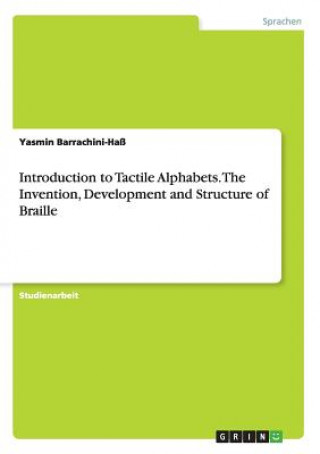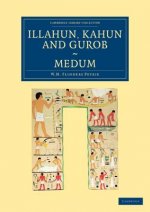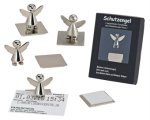
Code: 10938134
Introduction to Tactile Alphabets. The Invention, Development and Structure of Braille
by Yasmin Barrachini-Ha
Studienarbeit aus dem Jahr 2012 im Fachbereich Sprachwissenschaft / Sprachforschung (fachübergreifend), Note: 1,7, Universität Bremen (Fachbereich Sprach- und Literaturwissenschaften), Veranstaltung: Schriftsysteme- Typologie und ... more
- Language:
 German
German - Binding: Paperback
- Number of pages: 32
Publisher: Grin Publishing, 2016
- More about this

37.23 €
RRP: 40.01 €
You save 2.78 €

In stock at our supplier
Shipping in 15 - 20 days
You might also like
-

Indizieren - Visualisieren
30.38 € -5 % -

Juristische Probleme bei der Abgrenzung der Arbeitnehmeruberlassung zum Werkvertrag
54.84 € -7 % -

Illahun, Kahun and Gurob. Medum
44.57 € -

Husserl's Phenomenology
266.47 € -

Plants with Anti-Diabetes Mellitus Properties
312.87 € -

Capturing Darkness with Light
27.87 € -

MM. Les Conseillers de la Cour de Cassation
16.70 € -1 %
Give this book as a present today
- Order book and choose Gift Order.
- We will send you book gift voucher at once. You can give it out to anyone.
- Book will be send to donee, nothing more to care about.
More about Introduction to Tactile Alphabets. The Invention, Development and Structure of Braille
You get 94 loyalty points
 Book synopsis
Book synopsis
Studienarbeit aus dem Jahr 2012 im Fachbereich Sprachwissenschaft / Sprachforschung (fachübergreifend), Note: 1,7, Universität Bremen (Fachbereich Sprach- und Literaturwissenschaften), Veranstaltung: Schriftsysteme- Typologie und Geschichte, Sprache: Deutsch, Abstract: This term paper focuses mainly on the characteristics of Braille which are relevant from a linguistic point of view, but also discusses historical events of how Louis Braille invented the aforesaid writing system, as well as how the aforesaid writing system evolved over the past 187 years. It must also be said that this term paper focuses mainly on American English Braille (AEB), because this particular writing system is widely used, well documented, and has evolved faster than any other tactile writing system. However, other types of Braille are occasionally mentioned in this paper, too.§§Braille is a writing system that is mostly used by blind people or people who suffer from significant vision loss. However, individuals who are not visually impaired can also read it by using their eyesight. A special feature about Braille is that it can be read by using just one's finger tips.§§The first chapter deals with tactile alphabets in general. Since Braille is just one type of many existing tactile alphabets, this chapter clarifies its definition and variations. There are two different types of tactile alphabets. One is based on embossed Roman letters, and the second type of tactile alphabet is based on arbitrary symbols. Each type is further explained in a subchapter. The second chapter is about the invention and development of Braille. This chapter focuses, among other things, on the life of Braille, how he became blind and created his own writing system that evolved to be the most important reading and writing tool to many blind communities all over the world. In subchapter 2.2, it is also explained how Braille derived from an already existing tactile alphabet called night writing, and how this aforesaid writing system is structured.§§The third chapter discusses linguistic features and structures of Braille. The arrangement of AEB is discussed, as well as the difference between Grade 1 Braille and Grade 2 Braille. Moreover, the third chapter discusses how Braille can be used alternatively for all other writing systems, which, among other things, do not resemble the Latin alphabet, and how that leads eventually to different variations of Braille. Finally, the Unified English Braille (UEB) code is also included as a topic in the third chapter. The aforesaid chapter is followed by a conclusion, a list of references and a declaration of authenticity.
 Book details
Book details
37.23 €
- Full title: Introduction to Tactile Alphabets. The Invention, Development and Structure of Braille
- Author: Yasmin Barrachini-Ha
- Language:
 German
German - Binding: Paperback
- Number of pages: 32
- EAN: 9783668197220
- ISBN: 3668197229
- ID: 10938134
- Publisher: Grin Publishing
- Weight: 62 g
- Dimensions: 148 × 210 × 7 mm
- Date of publishing: 08. May 2016
Trending among others
-

Amigurumis - soft and cosy!
14.68 € -14 % -

Mein Kampf(German Language Edition)
29.17 € -17 % -

Disney Rapunzel (Puzzle)
13.07 € -4 % -

Emil und die Detektive
9.95 € -

Hitster - Summer Party
21.22 € -4 % -

KLEINE PRINZ
5.63 € -

Harry Potter und der Stein der Weisen (Harry Potter 1)
11.66 € -

Grammatik aktiv - Deutsch als Fremdsprache - 2. aktualisierte Ausgabe - A1-B1
22.63 € -

Mit Erfolg zum Goethe-Zertifikat C1
21.93 € -

Mein Kampf(German Language Edition)
43.97 € -12 % -

Save You
12.17 € -14 % -

Lippels Traum 1
7.24 € -14 % -

Save Me
12.17 € -14 % -

CATAN - Ergänzung 5-6 Spieler - Das Spiel
18 € -

Prüfungstraining DaF - C1
24.65 € -

Hitster - Guilty Pleasure
21.22 € -4 % -

Save Us
12.17 € -14 % -

Avocado Smash - 1ks
9.75 € -4 % -

Zettelmagnet Metall Schutzengel
6.53 € -30 % -

Herr der Diebe
10.56 € -14 % -

Disney Marvel Ghost Spider, GID 25cm
11.16 € -

Oldtimer Katalog Nr. 38
20.42 € -14 % -

Duden 12+: Kennst du das? Meine bunte Kinderwelt (Würfel)
8.24 € -12 % -

Menschen A1/1
9.65 € -13 % -

Nova Luna
21.73 € -9 % -

A-Grammatik
21.63 € -

Begegnungen
27.36 € -

Die Verwandlung
2.61 € -

Die Welt unter der Lupe - zu Lande
8.54 € -9 % -

Amigurumis - small and sweet!
16.09 € -6 % -

Anno 1800 - Die Erweiterung
21.22 € -4 % -

RBL Rubble & Crew Core Vehicle Motor
20.02 € -

GND PAW Plüsch 15 cm Everest
12.57 € -

Kennst du das? Meine kleine Lernwelt
8.95 € -13 % -

Hitster - Schlager Party
21.22 € -4 % -

Meine Reise durch Europa
10.05 € -9 % -

Wir Kinder vom Bahnhof Zoo
12.47 € -

Sechs nimmt!
7.74 € -9 % -

GND PAW Plüsch 15cm Tracker
11.87 € -

Pixi-8er-Set 254: Die beliebtesten Bilderbuch-Helden bei Pixi (8x1 Exemplar)
7.14 € -14 % -

Lobo 77
7.74 € -4 % -

Ravensburger Elfer raus! Der Klassiker, Kartenspiel 2 - 6 Spieler, Spiel ab 7 Jahren für Kinder und Erwachsene
9.75 € -4 % -

Ben liebt Anna
6.83 € -6 % -

Schreibtraining für das Goethe-Zertifikat B2. Übungsbuch
29.48 € -

Die Verwandlung
4.02 € -

Halali!
15.59 € -4 % -

Der Steppenwolf
10.66 € -

5 Minuten Jungsgeschichten für Erstleser
6.03 € -

My Rummy
19.71 €
Collection points Bratislava a 2642 dalších
Copyright ©2008-24 najlacnejsie-knihy.sk All rights reservedPrivacyCookies


 15549 collection points
15549 collection points Delivery 2.99 €
Delivery 2.99 € 02/210 210 99 (8-15.30h)
02/210 210 99 (8-15.30h)